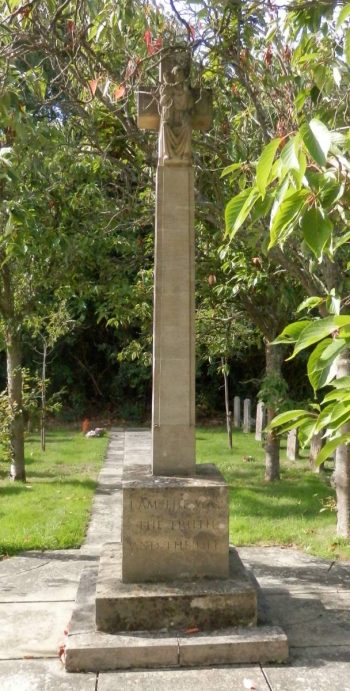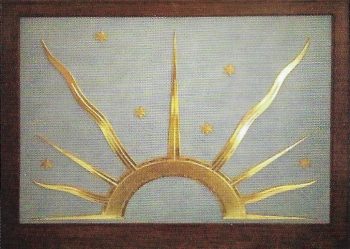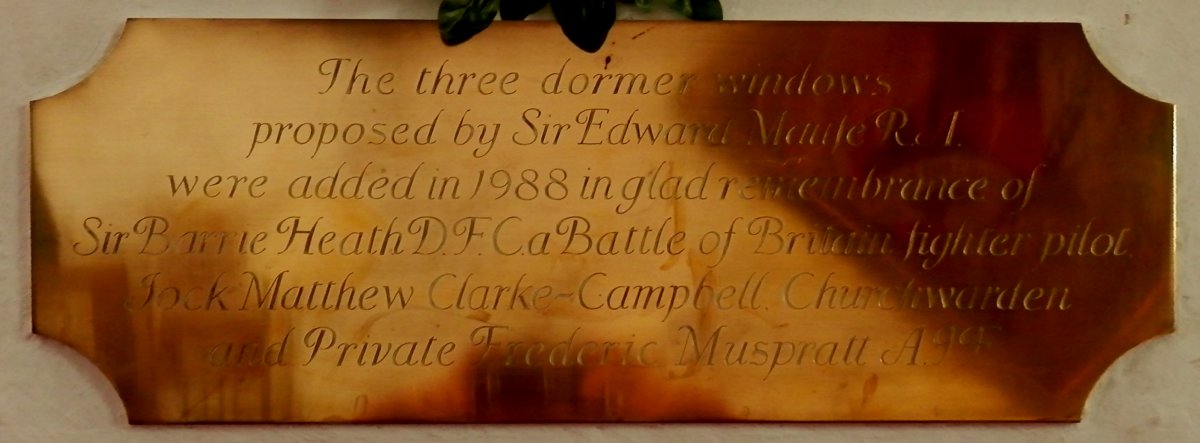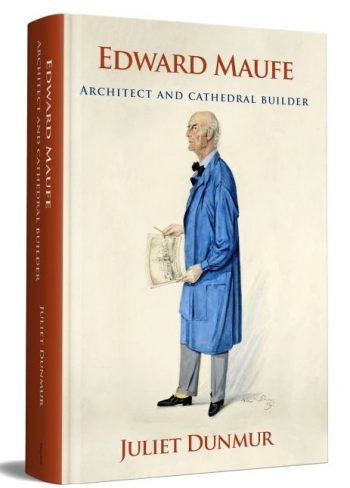Edward Maufe was knighted in 1954 for his work for the Imperial War Graves Commission and, in particular, the Runnymede Air Forces Memorial. He was busy completing Guildford Cathedral and working on the restoration of the Inns of Court at this period so perhaps had little time for the detailed concerns of Holy Trinity Penn. The next mention in the parish newsletters does not occur till 1961.
 Edward Maufe and his wife Prudence often worked together and so it is not surprising to find Revd Oscar Muspratt recording that he had dedicated the “beautiful new Sanctuary carpet chosen by Lady Maufe to tone with the new kneelers.” The same report notes that plans for the Churchyard extension had been worked out: “For over twelve months an immense amount of careful thought has been given to the intricate task of drafting the scheme for the permanent layout. Sir Edward Maufe has prepared a most attractive ground plan and the sketch of the central cross. These must now be submitted to the Diocesan Advisory Committee.” The intention was to make provision for the next hundred years. By September 1963 not only had the Faculty been granted but the appeal for funds had been sufficiently successful to enable Darsie Rawlins, the local, highly regarded sculptor, to start work on the cross that Edward specified was to be carved in Clipsham stone. Maufe’s attention to detail is illustrated by the fact that he personally selected the cherry trees that were planted as a central feature of the churchyard.
Edward Maufe and his wife Prudence often worked together and so it is not surprising to find Revd Oscar Muspratt recording that he had dedicated the “beautiful new Sanctuary carpet chosen by Lady Maufe to tone with the new kneelers.” The same report notes that plans for the Churchyard extension had been worked out: “For over twelve months an immense amount of careful thought has been given to the intricate task of drafting the scheme for the permanent layout. Sir Edward Maufe has prepared a most attractive ground plan and the sketch of the central cross. These must now be submitted to the Diocesan Advisory Committee.” The intention was to make provision for the next hundred years. By September 1963 not only had the Faculty been granted but the appeal for funds had been sufficiently successful to enable Darsie Rawlins, the local, highly regarded sculptor, to start work on the cross that Edward specified was to be carved in Clipsham stone. Maufe’s attention to detail is illustrated by the fact that he personally selected the cherry trees that were planted as a central feature of the churchyard.
Three years later it was proposed to move the organ, installed in 1947 and apparently blocking two windows in the south wall, to an acoustically better position on the west wall of the nave. This turned out to not be physically possible and the only alternative was to commission a new organ donated by a generous anonymous parishioner.
 This new organ, installed in 1967, was constructed by J.W. Walker & Sons of Ruislip in a case designed by Penelope Adamson RIBA, the architect responsible for the works, in consultation with Edward Maufe. According to Walker’s advertisement in Musical Opinion, June 1967, it was Sir Edward Maufe who designed “a magnificent ‘Rays of Glory’ scheme in blue and burnished gold, for the soffits which delicately balance the plain simplicity of the ancient font.”
This new organ, installed in 1967, was constructed by J.W. Walker & Sons of Ruislip in a case designed by Penelope Adamson RIBA, the architect responsible for the works, in consultation with Edward Maufe. According to Walker’s advertisement in Musical Opinion, June 1967, it was Sir Edward Maufe who designed “a magnificent ‘Rays of Glory’ scheme in blue and burnished gold, for the soffits which delicately balance the plain simplicity of the ancient font.”
The work required at that time turned out to be more significant than Oscar Muspratt had anticipated as, at the other end of the church, cracks in the east wall required three deep channels to be cut and filled with reinforced concrete and the entire building had to be rewired as bare wires were found in the roof. Although the church had to be closed for five months it had been transformed when it reopened. Not only was there the new organ above the repositioned font but the 14th century Doom painting was installed above the chancel arch for the first time since the reign of Henry VIII.
Maufe’s influence on Penn Church even extended after his death in 1974. A brass plaque records that “three dormer windows proposed by Sir Edward Maufe RA were added in 1988” to bring daylight to the south aisle. He must have suggested the idea to Revd. Muspratt many years before as part of the long term plan.

Compared with some of Edward Maufe’s other works such as Guildford Cathedral, the reconstruction of the London Inns of Court, St John’s College, Cambridge or his work for the Imperial (renamed in 1960: Commonwealth) War Graves Commission, Penn church and its churchyard was a very minor exercise for Sir Edward and does not get a mention in Juliet Dunmur’s book. For the parishioners of Penn however, it can be seen that his twenty-year involvement with the Church is very largely responsible for the way it looks today. Appropriately enough, some of his archives concerning Penn Church have ended up in Pennsylvania State University Library, USA, whilst others are held by the RIBA in London.
 Juliet Dunmur has recently published ‘Sir Edward Maufe, Architect and Cathedral Builder’, a biography of her grandparents, Edward Maufe and his wife Prudence, which recounts their fascinating lives. (ISBN 978-1-905597-92-5. Available from the author – j.dunmur@gmail.com for £20.00). For anyone wanting to know more about the man behind the sympathetic, organic changes to our church, or with an interest in twentieth century society, architecture, sculpture, design, planning, the impact of Swedish design on taste or how to conceive a church for a ‘deaf and dumb’ congregation, this book is strongly recommended.
Juliet Dunmur has recently published ‘Sir Edward Maufe, Architect and Cathedral Builder’, a biography of her grandparents, Edward Maufe and his wife Prudence, which recounts their fascinating lives. (ISBN 978-1-905597-92-5. Available from the author – j.dunmur@gmail.com for £20.00). For anyone wanting to know more about the man behind the sympathetic, organic changes to our church, or with an interest in twentieth century society, architecture, sculpture, design, planning, the impact of Swedish design on taste or how to conceive a church for a ‘deaf and dumb’ congregation, this book is strongly recommended.
Oliver Heal, June 2021
